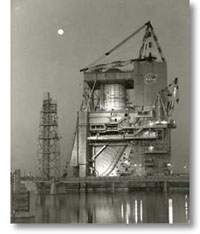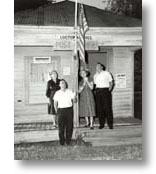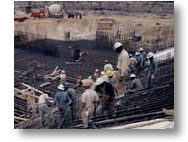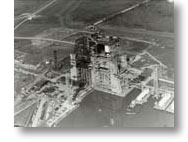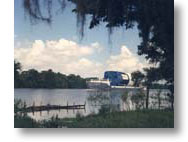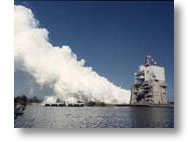- NASA Home
- | Centers
- | Stennis Home
- | About Stennis
- | Stennis History
Search Stennis
Stennis History
|
|
The site known today as NASA's John C. Stennis Space Center boasts a rich and colorful history dating as far back as 1699. Indians, settlers, pirates and soldiers shaped this part of Mississippi which now hosts modern-day explorers.
In October 1961, a historic announcement was made: the federal government had selected an area in Hancock County, Miss., to be the site of a static test facility for launch vehicles to be used in the Apollo manned lunar landing program.
It was the largest construction project in the state of Mississippi and the second largest in the United States at that time.
Less than eight years later, astronauts Neil Armstrong and Buzz Aldrin walked on the lunar surface, safely transported thousands of miles by a space vehicle whose boosters were tested and proven flight-worthy at Stennis Space Center.
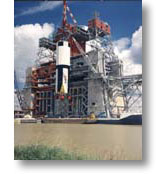 An S-IC stage of the Saturn V rocket is hoisted into place.
An S-IC stage of the Saturn V rocket is hoisted into place.
The center's primary mission at the onset was to flight certify all first and second stages of the Saturn V rocket for the Apollo program. This program began with a static test firing on April 23, 1966, and continued into the early 1970s.
Proof of the contributions made by Stennis Space Center to America's space program was that all the Apollo space vehicle boosters did their job without a single failure, including those for the Apollo 11 mission the landing of the first men on the moon.
From Apollo to the next mode of space travel.
Over the years, SSC has evolved into a multidisciplinary facility made up of NASA and 30 other resident agencies engaged in space and environmental programs and the national defense, including the U.S. Navy's world-class oceanographic research community.
What's in a Name?
SSC has undergone a number of name changes. Its original name, Mississippi Test Operations, was changed to Mississippi Test Facility in 1965. In 1974, the facility was named the National Space Technology Laboratories reporting to NASA Headquarters in Washington, D.C.
In May 1988, it was renamed the John C. Stennis Space Center in honor of U.S. Sen. John C. Stennis for his steadfast leadership and staunch support of the nation's space program.
